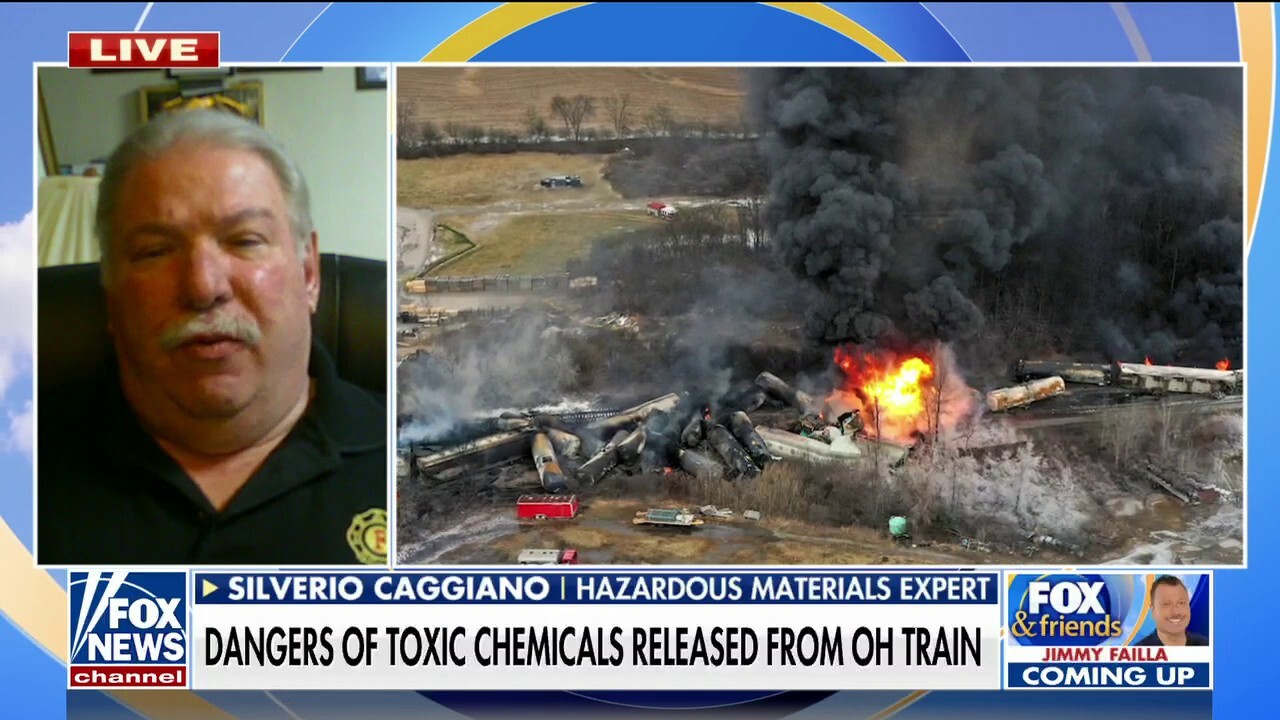Toxic Chemicals From Ohio Train Derailment: Months-Long Contamination

Table of Contents
Types of Toxic Chemicals Released and Their Properties
The derailment released a cocktail of hazardous materials, with vinyl chloride and butyl acrylate being among the most concerning. Understanding the properties of these chemicals is crucial to grasping the scale of the contamination.
-
Vinyl Chloride: A colorless, flammable gas used to make PVC plastic. It's classified as a human carcinogen, linked to liver cancer, brain cancer, and other serious illnesses. Exposure can cause dizziness, headaches, and nausea. Long-term exposure can lead to more severe health problems.
- Vinyl Chloride: A Deep Dive: The EPA considers vinyl chloride a highly toxic substance that persists in the environment, requiring extensive cleanup efforts. Controlled burns, employed to mitigate the immediate threat, released potentially harmful byproducts into the atmosphere. The long-term effects of this controlled burn are still being investigated.
-
Butyl Acrylate: A colorless liquid used in paints, adhesives, and textiles. It's an irritant, causing skin and eye irritation, respiratory problems, and potentially more severe reactions in higher concentrations. Its persistence in the soil and water is also a significant concern.
- Butyl Acrylate and Other Contaminants: Beyond vinyl chloride and butyl acrylate, other chemicals released included ethylene glycol monobutyl ether, ethylhexyl acrylate, and various other compounds, each posing its own unique health and environmental risks. Comprehensive testing is needed to fully assess the extent and long-term consequences of this complex mixture of pollutants.
Environmental Impact of the Ohio Train Derailment
The ecological consequences of the derailment are far-reaching and potentially devastating. Soil contamination near the derailment site poses a significant risk.
- Soil Contamination: The affected soil may remain contaminated for years, impacting plant growth and potentially leaching toxic substances into groundwater. This poses a significant risk to the local ecosystem and agricultural lands.
- Water Contamination: Nearby rivers and streams have shown signs of contamination. The impact on aquatic life, including fish, amphibians, and other organisms, is of great concern, potentially disrupting the entire food chain. Bioaccumulation of these chemicals in aquatic organisms can lead to higher concentrations further up the food chain.
- Ongoing Monitoring Efforts: While monitoring efforts are underway, their extent and long-term commitment remain questionable. The limitations of current testing methods and the vastness of the potentially affected area present major challenges. A detailed map illustrating the geographical spread of the contamination, including soil and water samples, would be crucial for informing remediation strategies.
Health Concerns and Impacts on the Community
Residents near the derailment site have reported a range of health issues, further emphasizing the severity of this environmental disaster.
- Reported Health Issues: Many residents have experienced respiratory problems, headaches, skin irritation, and other symptoms consistent with exposure to toxic chemicals. The long-term effects of this exposure are unknown and require thorough investigation.
- Long-Term Health Risks: The potential for long-term health impacts, including chronic illnesses and birth defects, is a major cause for concern. Extensive epidemiological studies are needed to track the health outcomes of those exposed to the released chemicals. The psychological impact of the disaster on residents adds another layer of complexity to the ongoing health crisis.
- Ongoing Health Studies: While some health monitoring programs are in place, their comprehensiveness and long-term funding are vital for assessing the full scope of the health consequences.
Government Response and Accountability
The government's response to the derailment has faced significant criticism, raising questions about transparency and accountability.
- Critique of Response: The initial response has been criticized for its slowness and lack of proactive measures. The lack of comprehensive and readily available information regarding the released chemicals and their potential impact on public health fueled public distrust.
- Legal and Regulatory Aspects: Investigations into the cause of the derailment and the regulatory oversight of hazardous materials transport are ongoing. The outcomes of these investigations will be pivotal in determining accountability and preventing similar incidents.
- Transparency Concerns: Public concerns about transparency regarding the extent of contamination and the long-term cleanup plans remain high.
Community Action and Advocacy
Despite the challenges, the affected community has demonstrated remarkable resilience and is actively fighting for justice and environmental remediation.
- Community Efforts: Local residents and advocacy groups are working to raise awareness about the ongoing contamination, demand greater transparency from government agencies, and push for comprehensive cleanup efforts. Legal actions have been taken to hold responsible parties accountable.
- Community Resource Centers: Community support centers have been established to provide resources, support, and information to affected residents.
Conclusion
The Ohio train derailment's lasting consequences – long-term contamination from toxic chemicals – are a stark reminder of the devastating impact of industrial accidents. The ongoing health concerns, environmental damage, and questions surrounding government accountability demand sustained attention. Continued monitoring, thorough cleanup efforts, and strong regulatory reform are crucial to mitigate the long-term effects of this disaster. We must learn from this tragedy and advocate for stricter safety regulations and greater transparency in the handling of hazardous materials to prevent future incidents. Stay informed about the ongoing situation, support affected communities through organizations such as [insert relevant organization links here], and demand accountability from those responsible for this devastating Ohio train derailment contamination. Let's collectively work towards preventing future catastrophes related to toxic chemical spills and ensuring a healthier, safer environment for all.

Featured Posts
-
 City Pickle Building Huge New Pickleball Complex In Brooklyn Nyc
May 18, 2025
City Pickle Building Huge New Pickleball Complex In Brooklyn Nyc
May 18, 2025 -
 Cops Investigate Homicide In Brooklyn Bridge Park
May 18, 2025
Cops Investigate Homicide In Brooklyn Bridge Park
May 18, 2025 -
 King Day A Divided Nations Approach To The Holiday
May 18, 2025
King Day A Divided Nations Approach To The Holiday
May 18, 2025 -
 Kanye West Bianca Censoris Spanish Dinner Amidst Relationship Speculation
May 18, 2025
Kanye West Bianca Censoris Spanish Dinner Amidst Relationship Speculation
May 18, 2025 -
 Taylor Swift Blake Lively And The It Ends With Us Controversy An Exclusive Look
May 18, 2025
Taylor Swift Blake Lively And The It Ends With Us Controversy An Exclusive Look
May 18, 2025
Latest Posts
-
 Christophe Mali A Onet Le Chateau Le Concert De La Saison
May 18, 2025
Christophe Mali A Onet Le Chateau Le Concert De La Saison
May 18, 2025 -
 Concert De Cloture Saison Onet Le Chateau Christophe Mali
May 18, 2025
Concert De Cloture Saison Onet Le Chateau Christophe Mali
May 18, 2025 -
 Onet Le Chateau Christophe Mali En Concert Pour La Saison
May 18, 2025
Onet Le Chateau Christophe Mali En Concert Pour La Saison
May 18, 2025 -
 The Brooklyn Bridge Story As Told By Barbara Mensch
May 18, 2025
The Brooklyn Bridge Story As Told By Barbara Mensch
May 18, 2025 -
 Posluchaj Podcastu Stan Wyjatkowy Onetu I Newsweeka Aktualnosci Dwa Raz W Tygodniu
May 18, 2025
Posluchaj Podcastu Stan Wyjatkowy Onetu I Newsweeka Aktualnosci Dwa Raz W Tygodniu
May 18, 2025
